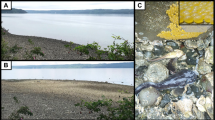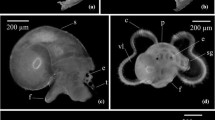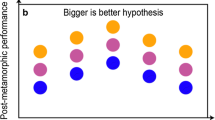Abstract
Phenotypic plasticity in hatching age has been documented in many animals. A growing body of research indicates that embryos can rapidly hatch to escape egg-stage risk. However, fewer studies have tested whether selective tradeoffs in post-hatching stages favor trait plasticity. We assessed hatching plasticity and its benefits to the larval stage in five species of Neotropical glassfrogs (Centrolenidae). Glassfrog embryos develop on terrestrial vegetation and larvae in benthic stream sediments; thus hatching involves a dramatic habitat shift, when hatchlings must dive past stream fish to reach larval refuges. We found that all five species have extensive plasticity in hatching age and can delay hatching to more than double their minimum embryonic period. Along a stream in Panama, we found evidence that early hatching is induced by the risk of embryo predation, dehydration, and fungal infections. Differences in hatching timing were coupled with changes in hatchling phenotypes, such that younger hatchlings were smaller and less developed than older individuals. To assess locomotor function we measured diving speed, a key performance trait for newly hatched larvae. Older hatchlings dove 1.4–3.8 times faster than younger ones, which would reduce their exposure to predators in the water column. To assess the potential for exotrophic growth, we measured digestive system morphology and feeding onset across hatching ages. Younger hatchlings had intact yolk sacs and spent 4.5–6 days as larvae before feeding, while older hatchlings entered the water with well-developed guts and fed immediately. Therefore, while early hatching enables embryos to escape egg-stage risk, it is associated with initial performance costs and a lag before feeding in the larval stage. We recovered consistent results across multiple genera of glassfrogs, supporting that hatching plasticity is widespread, ancient, and has been maintained by shared selective trade-offs in this family.




Similar content being viewed by others
References
Angermeier PL, Karr JR (1983) Fish communities along environmental gradients in a system of tropical streams. Environ Biol Fishes 9:117–135
Armstrong AF, Blackburn HN, Allen JD (2012) A novel report of hatching plasticity in the phylum echinodermata. Am Nat 181:264–272
Bates D, Maechler M, Bolker B, Walker S (2015) Fitting linear mixed-effects models using lme4. J Stat Softw 67:1–48
Buckley CR, Michael SF, Irschick DJ (2005) Early hatching decreases jum** performance in a direct-develo** frog, Eleutherodactylus coqui. Funct Ecol 19:67–72
Castroviejo-Fisher S, Guayasamin JM, Gonzalez-Voyer A, Vilà C, Ebach M (2014) Neotropical diversification seen through glassfrogs. J Biogeogr 41:66–80
Day T, Rowe L (2002) Developmental thresholds and the evolution of reaction norms for age and size at life-history transitions. Am Nat 159:338–350
Dayton GH, Saenz D, Baum KA, Langerhans RB, DeWitt TJ (2005) Body shape, burst speed and escape behavior of larval anurans. Oikos 111:582–591
Delia JRJ, Ramirez-Bautista A, Summers K (2014) Glassfrog embryos hatch early after parental desertion. Proc R Soc B Biol Sci 281:2013–3237
Delia J, Bravo-Valencia L, Warkentin KM (2017) Patterns of parental care in Neotropical glassfrogs: fieldwork alters hypotheses of sex-role evolution. J Evol Biol 30:898–914
Delia J, Bravo-Valencia L, Warkentin KM (in revision) The evolution of extended parental care in glassfrogs: egg-clutch phenotypes might mediate coevolution between the sexes. Ecol Monogr
Gomez-Mestre I, Touchon JC, Warkentin KM (2006) Amphibian embryo and parental defenses and a larval predator reduce egg mortality from water mold. Ecology 87:2570–2581
Gomez-Mestre I, Wiens JJ, Warkentin KM (2008) Evolution of adaptive plasticity: risk-sensitive hatching in neotropical leaf-breeding treefrogs. Ecol Monogr 78:205–224
Gomez-Mestre I, Pyron RA, Wiens JJ (2012) Phylogenetic analyses reveal unexpected patterns in the evolution of reproductive modes in frogs. Evolution 66:3687–3700
Gosner KL (1960) A simplified table for staging anuran embryos and larvae with notes on identification. Herpetologica 16:183–190
Hawley TJ (2006) Embryonic development and mortality in Hyalinobatrachium pulveratum (Anura: Centrolenidae) of south-western Costa Rica. J Trop Ecol 22:731–734
Hayes MP (1983) A technique for partitioning hatching and morality estimates in leaf-breeding frogs. Herpetol Rev 14:115–116
Hinde CA, Johnstone RA, Kilner RM (2010) Parent-offspring conflict and coadaptation. Science 327:1373–1376
Hoffman H (2010) The glass frog tadpoles of Costa Rica (Anura: Centrolenidae): a study of morphology. Abh Senckenberg Ges Naturforschung 567:1–78
Hutter CR, Guayasamin JM, Wiens JJ (2013) Explaining Andean megadiversity: the evolutionary and ecological causes of glassfrog elevational richness patterns. Ecol Lett 16:1135–1144
Kölliker M, Royle NJ, Smiseth PT (2012) Parent-offspring co-adaptation. In: Royle NJ, Smiseth PT, Kölliker M (eds) The evolution of parental care. Oxford University Press, Oxford, pp 285–303
Lehtinen RM, Georgiadis AP (2012) Observations on parental care in the glass frog Hyalinobatrachium orientale (Anura: Centrolenidae) from Tobago, with comments on its natural history. Phyllomedusa 11:75–77
Martin KLM (1999) Ready and waiting: delayed hatching and extended incubation of anamniotic vertebrate terrestrial eggs. Am Zool 39:279–288
Moran NA (1992) The evolutionary maintenance of alternative phenotypes. Am Nat 139:971–989
Nokhbatolfoghahai M, Pollock CJ, Downie JR (2015) Oviposition and development in the glass frog Hyalinobatrachium orientale (Anura: Centrolenidae). Phyllomedusa 14:3
Poo S, Bickford DP (2014) Hatching plasticity in a southeast Asian tree frog. Behav Ecol Sociobiol 68:1733–1740
R Core Team (2017) R: a language and environment for statistical computing. R Foundation for Statistical Computing, Vienna, Austria. http://www.R-project.org/. Accessed Mar 2017
Royle NJ, Hartley IR, Parker GA (2004) Parental investment and family dynamics: interactions between theory and empirical tests. Popul Ecol 46:231–241
Salica MJ, Vonesh JR, Warkentin KM (2017) Egg clutch dehydration induces early hatching in red-eyed treefrogs, Agalychnis callidryas. PeerJ 5:e3549
Schneider CA, Rasband WS, Eliceiri KW (2012) NIH image to ImageJ: 25 years of image analysis. Nat Methods 9:671–675
Shine R (1978) Propagule size and parental care: the “safe harbor” hypothesis. J Theor Biol 75:417–424
Teplitsky C, Plenet S, Léna JP, Mermet N, Malet E, Joly P (2005) Escape behaviour and ultimate causes of specific induced defenses in an anuran tadpole. J Evol Biol 18:180–190
Touchon JC, Warkentin KM (2010) Short- and long-term effects of the abiotic egg environment on viability, development and vulnerability to predators of a neotropical anuran. Funct Ecol 24:566–575
Touchon JC, Urbina J, Warkentin KM (2011) Habitat-specific constraints on induced hatching in a treefrog with reproductive mode plasticity. Behav Ecol 22:169–175
Touchon JC, McCoy MW, Vonesh JR, Warkentin KM (2013) Effects of plastic hatching timing carry over through metamorphosis in red-eyed treefrogs. Ecology 94:850–860
Van Buskirk J (2016) A meta-analysis on facultative responses of embryonic amphibians to predation risk. Copeia 104:691–696
Via S, Lande R (1985) Genotype-environment interaction and the evolution of phenotypic plasticity. Evolution 39:505–522
Villa J, Valerio CE (1982) Red, white and brown. Preliminary observations on the color of the centrolenid tadpole (Amphibia: Anura: Centrolenidae). Brenesia 19:1–16
Vonesh JR (2005) Egg predation and predator-induced hatching plasticity in the African reed frog, Hyperolius spinigularis. Oikos 2:241–252
Vonesh JR, Bolker BM (2005) Compensatory larval responses shift trade-offs associated with predator-induced hatching plasticity. Ecology 86:1580–1591
Warkentin KM (1995) Adaptive plasticity in hatching age: a response to predation risk trade-offs. Proc Natl Acad Sci 92:3507–3510
Warkentin KM (1999) Effects of hatching age on development and hatchling morphology in the red-eyed treefrog, Agalychnis callidryas. Biol J Linn Soc 68:443–470
Warkentin KM (2000) Wasp predation and wasp-induced hatching of red-eyed treefrog eggs. Anim Behav 60:503–510
Warkentin KM (2011a) Environmentally cued hatching across taxa: embryos respond to risk and opportunity. Integr Comp Biol 51:14–25
Warkentin KM (2011b) Plasticity of hatching in amphibians: evolution, trade-offs, cues and mechanisms. Integr Comp Biol 51:111–127
Warkentin KM, Currie CC, Rehner SA (2001) Egg-killing fungus induces early hatching of red-eyed treefrog eggs. Ecology 82:2860–2869
Warkentin KM, Cuccaro Diaz J, Güell BA, Jung J, Kim SJ, Cohen KL (2017) Developmental onset of escape-hatching responses in red-eyed treefrogs depends on cue type. Anim Behav 129:103–112
Watkins TB (1996) Predator-mediated selection on burst swimming performance in tadpoles of the pacific tree frog, Pseudacris regilla. Physiol Zool 69:154–167
Werner EE (1986) Amphibian metamorphosis: growth rate, predation risk, and the optimal size at transformation. Am Nat 128:319–341
Werner EE, Gilliam JF (1984) The ontogenetic niche and species interactions in size-structured populations. Annu Rev Ecol Syst 15:393–425
Wilbur HM, Collins JP (1973) Ecological aspects of amphibian metamorphosis. Science 182:1305–1314
Williams GC (1966) Adaptation and natural selection: a critique of some current evolutionary thought. Princeton University Press, Princeton
Willink B, Palmer MS, Landberg T, Vonesh JR, Warkentin KM (2014) Environmental context shapes immediate and cumulative costs of risk-induced early hatching. Evol Ecol 28:103–116
Yoshioka M, Meeks C, Summers K (2016) Evidence for begging as an honest signal of offspring need in the biparental mimic poison frog. Anim Behav 113:1–11
Acknowledgements
We are grateful to L Bravo-Valencia for assisting with field monitoring, and to C Brown, and E Moody, MA Seid, and JFA Traniello for identifying glassfrog predators. P Buston, Lisa Schulte, the associate editor, and an anonymous reviewer kindly provided important feedback on an early version of this manuscript. Funding to JD was provided by the Smithsonian Tropical Research Institute, Boston University, National Science Foundation (DDIG, IOS-1501531), Lewis and Clark Foundation, American Society of Naturalists, Society for the Study of Evolution, Animal Behavior Society, and Society for the Study of Amphibians and Reptiles; to JRO by an REU site Grant to STRI (1359299); and to MSN and KMW by the National Science Foundation (IOS-1354072 to KMW).
Author information
Authors and Affiliations
Corresponding author
Ethics declarations
Conflict of interest
The authors declare that they have no conflict of interest.
Ethical approval
All research was conducted in accordance with approved IACUC protocols from the Smithsonian Tropical Research Institute (2011-0426-2014-04, 2014–0601-2017-2-A4), and permits provided from the Ministerio de Ambiente, Panama (SE/A-47-11, SC/A-24-12, SE/A-65-13, SE/A-70-13, SE/A-51-14, SEX/A-93-14, SE/A-63-15, SC/A-28-16).
Electronic supplementary material
Below is the link to the electronic supplementary material.
Rights and permissions
About this article
Cite this article
Delia, J., Rivera-Ordonez, J.M., Salazar-Nicholls, M.J. et al. Hatching plasticity and the adaptive benefits of extended embryonic development in glassfrogs. Evol Ecol 33, 37–53 (2019). https://doi.org/10.1007/s10682-018-9963-2
Received:
Accepted:
Published:
Issue Date:
DOI: https://doi.org/10.1007/s10682-018-9963-2




